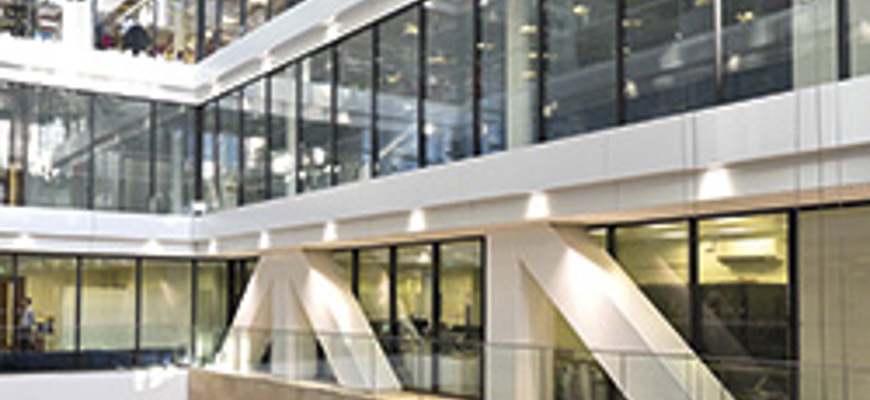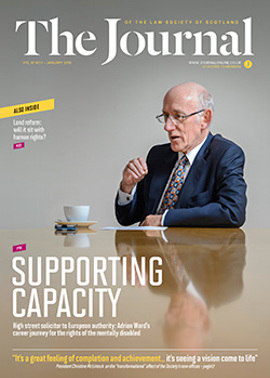Team building

Gone are the New Town railings and A-listed stonework, the porch, the wooden panelling, the staid interior, somewhat gloomy despite its enormous sash windows. Now a revolving door (there is enough glass that I have tried to come out of it too soon) takes you into a large, bright atrium where security people direct you up a level to the Society’s own reception, and the headquarters your membership money is now providing. What does the deal bring?
The three townhouses in Drumsheugh Gardens claimed 18,869 square feet; Atria One, the new Morrison Street HQ just uphill from the Edinburgh International Conference Centre, occupies about 19,000. There any similarity ends.
All 125 or so of the Society’s staff are on the one level, all in open plan working space. One might imagine from that a large barn of a place, but not so. The office area surrounds the atrium space, which extends the height of the building; sectioned areas of varying sizes each accommodate two or more teams; and these areas are bounded by numerous meeting rooms, including the Council room, a staff kitchen and informal area (providing much improved facilities), the IT hub and so on.
The profession’s stamp can certainly be seen. The artwork featuring the Society’s shield has survived; the photo gallery of past Presidents, albeit in reduced size portraits, now lines one main corridor; shelves of (now less dusty) bound journals and law reports are still on display; the public meeting rooms are named after institutional writers such as Bankton, Erskine and Mackenzie. But alongside them, information screens are constantly changing, and everything about the premises speaks of the new, the modern, the 21st century way of doing business. Much as any sizeable legal practice would wish to present itself to the world, in fact.
An environment transformed
“It’s been a long time in the planning, so it’s a great feeling of completion and achievement in seeing it all come to life,” Christine McLintock, the President, told me on showing me round for the first time. “Drumsheugh Gardens was not designed to be a 21st century office in terms of the cabling for all the technology etc. So it’s seeing a vision come to life, I think that’s fair to say, and although there was a lot of anxiety for some people in moving to a new place after so long in Drumsheugh, in no time at all people have been saying they feel at home here. It’s just a really nice atmosphere.”
She adds: “My and Lorna’s warm thanks and congratulations to everyone involved, from the project team to IT, facilities, the external professionals that were involved. And Henry [Robson, deputy chief executive] particularly, the head of the project team internally. The sign of a good office move is that they are all exhausted and everybody else feels it was just so easy!”
What are the biggest differences for the Society itself from a working point of view?
“Technology, because this building is built to facilitate the most up-to-date and effective high speed broadband and so on. Also it’s completely open plan for everyone, from the most recently joined office junior to the chief executive, and the reason for that is that everyone needs to work together effectively in teams. I remember from talking to the staff about my own experience when moving to open plan for the first time, that some of them were very hesitant about it and resistant to it because they valued quiet time, thinking time – the same people, quite often some who were most worried about it, in short order would be the ones who were promoting it as a really effective way to work and saying they wouldn’t go back to sitting in a room.”
What about occasions on which members of staff have to engage in confidential discussions or advice?
“That’s all been factored into the planning. There are plenty of internal working rooms, so when confidentiality is an issue there are spaces to go and have confidential discussions. The technology allows you to transfer a phone call from your desk, say to your mobile or an internal meeting room. So if you need to walk away because something that isn’t suitable for an open plan environment crops up unexpectedly, you can take the call to an appropriate space.”
As a further aspect of effective teamworking, McLintock adds that with the old office and its warren of rooms, there were many people who never saw each other. “There are so many different bits of the organisation, and the offices didn’t promote people getting together and talking unless they really had to. All those stairs were a barrier; now it’s more collegiate and people will be more likely to pop across and have a chat with a colleague in another team. It feels more like an organisation instead of lots of different smaller teams working in isolation. That will be transformational, I think.”
Council members and others engaging with the Society will also find improvements. Those joining Council meetings by conference call will enjoy significantly better audio, and the new meeting and training rooms will enable the Update team to hold many events without having to hire facilities elsewhere.
Making the money work
Questions have been asked whether it would have been more cost effective for the Society to move away from Edinburgh. That too was considered. “We also looked outside the city: over 40 properties were viewed in the course of the planning for the move, not just in Edinburgh, not at all,” McLintock confirms. “But we surveyed all our volunteers – there are hundreds of those on committees, in addition to Council members – and all our staff, as well as members who visit, people coming from all over Scotland, many by public transport, and it just became clear that for people we engage with, it was going to be much more effective to be in a city centre location. It was also cost effective: the Society has to pay travel expenses for volunteers travelling to the building, and it was very clear that the city centre was the best solution. For stakeholders as well, many that we work with daily are based in Edinburgh – SLAB, the Scottish Government, Scottish Courts & Tribunal Service and so on.”
The President indeed extends a personal invitation to solicitors who find themselves in Edinburgh to come in and see the facilities, and use the wi-fi or simply the working space of the members’ drop-in area. Meeting rooms can also be booked. “We’re flexible enough that we can accommodate most needs. A queue at the door would be a nice problem to have!”
So Atria One it is, for the next 15 years anyway – a standard length for a commercial lease. The Society reckons it has a good deal on rent for the first five years, after which a review is due.
The other frequently asked question is, what happens to the sale proceeds of Drumsheugh Gardens? “Our view is that that money should be invested to provide an income stream going forward, and that way existing and future members get the benefit of that asset,” McLintock replies. “That’s basically the intention at present, but Council and the Finance Committee will be keeping that under review as they always do.
“In terms of the strategy, the intention is to provide more services to all members that they can be using on a daily basis, and also to increase the amount of income coming into the Society. We are a not-for-profit organisation, but the intention is to make best use of sponsorship and commercial partnerships so that the Society is not wholly reliant on subscriptions for its income. That then allows us to do two things: one, to use that money to provide all those added value services, and the more money we have the more we can invest in services to members; but also it allows us to keep the practising certificate fee at a reasonable level.”
All eyes on the strategy
Now that the move is out of the way, what are the next big projects?
“Implementing the five year strategy is our focus, but this building is a big part of that in many ways and I genuinely believe this will be transformational in the way the Society works internally and externally, in terms of its engagement with its members and its volunteers and the way the staff work together and with external links. So we have high hopes for that. But the focus is very much on the day job: stick to the knitting; implement the strategy. The senior management team has been restructured and is all in place now; there is lots of work going on with that group and with Lorna on the annual plan, on the first year of the strategy.”
“It’s going to be a really exciting year,” the President concludes. “And I’m confident members will see progress very quickly in terms of the new strategy.”
In this issue
- Cutting the RoS bouncebacks
- Landlords still?
- Split parenting: fewer tears
- Brussels briefing
- Reading for pleasure
- Opinion: Frankie McCarthy
- Book reviews
- Profile
- President's column
- DPA: one year on
- People on the move
- Team building
- Ward's words
- The end of deeds of conditions?
- Human rights and land reform: unanswered questions
- Aye to Brussels
- Appeals: the new landscape
- The 2015 Act: some more thoughts
- Three months in planning
- Buy-to-let: no longer a good bet?
- Scottish Solicitors Discipline Tribunal
- What is ScotLIS?
- Energy input
- Law firms help students' business skills
- Paralegal pointers
- Law reform roundup
- CML Handbook amended
- Service eases stress of separating parents
- Appreciation: Tahir Elçi
- The rocky road to good intentions
- Risk review 2015, risk forecast 2016
- Ask Ash
- What's in store for SYLA in 2016?
- Reflections from the Commission






